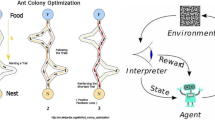Abstract
Scheduling of aircraft assembling activities is proven as a non-deterministic polynomial-time hard problem; which is also known as a typical resource-constrained project scheduling problem (RCPSP). Not saying the scheduling of the complex assemblies of an aircraft, even for a simple product requiring a limited number of assembling operations, it is difficult or even infeasible to obtain the best solution for its RCPSP. To obtain a high quality solution in a short time frame, resource constraints are treated as the objective function of an RCPSP, and an adaptive genetic algorithm (GA) is proposed to solve demand-driven scheduling problems of aircraft assembly. In contrast to other GA-based heuristic algorithms, the proposed algorithm is innovative in sense that: (1) it executes a procedure with two crossovers and three mutations; (2) its fitness function is demand-driven. In the formulation of RCPSP for aircraft assembly, the optimizing criteria are the utilizations of working time, space, and operators. To validate the effectiveness of the proposed algorithm, two encoding approaches have been tested with the real data of demand.











Similar content being viewed by others
References
Afruzi EN, Roghanian E, Najafi AA, Mazinani M (2013) A multi-mode resource-constrained discrete time–cost tradeoff problem solving using an adjusted fuzzy dominance genetic algorithm. Sci Iran 20(3):931–944
Afshar-Nadjafi B, Rahimi A, Karimi H (2013) A genetic algorithm for mode identity and the resource constrained project scheduling problem. Sci Iran 20(3):824–831
Agarwal A, Colak S, Erenguc S (2011) A neurogenetic approach for the resource-constrained project scheduling problem. Comput Oper Res 38(1):44–50
Agpak K (2010) An approach to find task sequence for re-balancing of assembly lines. Assem Autom 30(4):378–387
Artigues C (2008) The resource-constrained project scheduling problem. In: Artigues C, Demassey S, Neron E (eds) Resource-constrained project scheduling: models, algorithms, extensions and application. ISTE Ltd and Wiley, London and Hoboken, pp 21–36
Bakshi T, Sarkar B, Sanyal SK (2012) An evolutionary algorithm for multi-criteria resource constrained project scheduling problem based on PSO. Procedia Technol 6:231–238
Baradaran S, Fatemi Ghomi SMT, Mobini M, Hashemin SS (2010) A hybrid scatter search approach for resource-constrained project scheduling problem in PERT-type networks. Adv Eng Softw 41(7–8):966–975
Baradaran S, Fatemi Ghomi SMT, Ranjbar M, Hashemin SS (2012) Multi-mode renewable resource-constrained allocation in PERT networks. Appl Soft Comput 12(1):82–90
Bautista J, Pereira J (2007) Ant algorithms for a time and space constrained assembly line balancing problem. Eur J Oper Res 177(3):2016–2032
Bi ZM, Wang LH, Wu C, Yang G, Zhang D (2013) Multidisciplinary design optimization for engineering. Math Probl Eng 1–2 (Article ID 351097)
Bi ZM, Zhang WJ (2000) Concurrent optimal design of modular robotic configuration. J Robot Syst 18(2):77–87
Bi ZM (2010) Computer integrated reconfigurable experimental platform from ergonomic study of vehicle body design. Int J Comput Integr Manuf 23(11):968–978
Bi ZM, Lang SYT, Orban P, Verner M (2007) An integrated design toolbox for tripod-based parallel kinematic machines. ASME J Mech Des 129(8):799–807
Chaudhry S, Varano M, Xu L (2000) Systems research, genetic algorithms, and information systems. Syst Res Behav Sci 17(2):149–162
Chen PH, Weng HJ (2009) A two-phase GA model for resource-constrained project scheduling. Autom Constr 18(4):485–498
Chen RM (2011) Particle swarm optimization with justification and designed mechanisms for resource-constrained project scheduling problem. Expert Syst Appl 38(6):7102–7111
Chen Z, Xu L (2001) An object-oriented Intelligent CAD System for ceramic kiln. Knowl-Based Syst 14(5–6):263–270
Duan L, Xu L (2012) Business intelligence for enterprise systems: a survey. IEEE Trans Ind Inf 8(3):679–687
Elloumi S, Fortemps P (2010) A hybrid rank-based evolutionary algorithm applied to multi-mode resource-constrained project scheduling problem. Eur J Oper Res 205(1):31–41
Feng S, Xu L, Tang C, Yang S (2003) An intelligent agent with layered architecture for operating systems resource management. Expert Syst 20(4):171–178
Ghoddousi P, Eshtehardian E, Jooybanpour S, Javanmardi A (2013) Multi-mode resource-constrained discrete time–cost-resource optimization in project scheduling using non-dominated sorting genetic algorithm. Autom Constr 30:216–227
Gonçalves JF, Mendes JJM, Resende MGC (2005) A hybrid genetic algorithm for the job shop scheduling problem. Eur J Oper Res 167(1):77–95
Hurink JL, Kok AL, Paulus JJ, Schutten JMJ (2011) Time-constrained project scheduling with adjacent resources. Comput Oper Res 38(1):310–319
Jarboui B, Damak N, Siarry P, Rebai A (2008) A combinatorial particle swarm optimization for solving multi-mode resource-constrained project scheduling problems. Appl Math Comput 195(1):299–308
Jiang Y, Xu L, Wang H, Wang H (2009) Influencing factors for predicting financial performance based on genetic algorithms. Syst Res Behav Sci 26(6):661–673
Kim JL (2007) Permutation-based elitist genetic algorithm using serial scheme for large-sized resource-constrained project scheduling. In: Henderson SG et al (eds) Proceedings of the 2007 winter simulation conference, 9–12 Dec 2007, Washington, pp 2112–2118
Kim KW, Gen M, Yamazaki G (2003) Hybrid genetic algorithm with fuzzy logic for resource-constrained project scheduling. Appl Soft Comput 2(3):174–188
Kim KW, Yun YS, Yoon JM, Gen M, Yamazaki G (2005) Hybrid genetic algorithm with adaptive abilities for resource-constrained multiple project scheduling. Comput Ind 56(2):143–160
Koonce DA, Tsai SC (2000) Using data mining to find patterns in genetic algorithm solutions to a job shop schedule. Comput Ind Eng 38(3):361–374
Li F, Xu L, Jin C, Wang H (2011) Intelligent bionic genetic algorithm (IB-GA) and its convergence. Expert Syst Appl 38(7):8804–8811
Li F, Xu L, Jin C, Wang H (2011) Structure of multi-stage composite genetic algorithm (MSC-GA) and its performance. Expert Syst Appl 38(7):8929–8937
Li J, Wang K, Xu L (2009) Chameleon based on clustering feature tree and its application in customer segmentation. Ann Oper Res 168:225–245
Liberatore MJ, Pollack-Johnson B, Smith CA (2001) Project management in construction: software use and research direction. J Constr Eng Manag 127(2):101–107
Lin DP, Lee CKM, William H (2013) Multi-level genetic algorithm for the resource-constrained re-entrant scheduling problem in the flow shop. Eng Appl Artif Intell 26(4):1282–1290
Liu TK, Chen CH, Chou JH (2010) Optimization of short-haul aircraft schedule recovery problems using a hybrid multiobjective genetic algorithm. Expert Syst Appl 37(3):2307–2315
Lova A, Tormos P, Cervantes M, Barber F (2009) An efficient hybrid genetic algorithm for scheduling projects with resource constraints and multiple execution modes. Int J Prod Econ 117(2):302–316
Magalheas-mendes J (2008) Project scheduling under multiple resources constraints using a genetic algorithm. WSEAS Trans Bus Econ 11(5):487–496
Mendes JJM, Gonçalves JF, Resende MGC (2009) A random key based genetic algorithm for the resource constrained project scheduling problem. Comput Oper Res 36(1):92–109
Mobini M, Mobini Z, Rabbani M (2011) An artificial immune algorithm for the project scheduling problem under resource constraints. Appl Soft Comput 11(2):1975–1982
Montoya-Torres JR, Edgar Gutierrez-Franco E, Pirachicán-Mayorga C (2010) Project scheduling with limited resources using a genetic algorithm. Int J Proj Manag 28(6):619–628
Moumene K, Ferland JA (2009) Activity list representation for a generalization of the resource-constrained project scheduling problem. Eur J Oper Res 199(1):46–54
Neumann K, Zimmermann J (2000) Procedures for resource leveling and net present value problems in project scheduling with general temporal and resource constraints. Eur J Oper Res 127(2):425–443
Paraskevopoulos DC, Tarantilis CD, Ioannou G (2012) Solving project scheduling problems with resource constraints via an event list-based evolutionary algorithm. Expert Syst Appl 39(4):3983–3994
Ponz-Tienda JL, Yepes V, Pellicer E, Moreno-Flores J (2013) The resource leveling problem with multiple resources using an adaptive genetic algorithm. Autom Constr 29(2013):161–172
Ranjbar M, Kianfar F (2007) Solving the discrete time/resource trade-off problem in project scheduling with genetic algorithms. Appl Math Comput 191(2):451–456
Ranjbar M, Kianfar F, Shadrokh S (2008) Solving the resource availability cost problem in project scheduling by path relinking and genetic algorithm. Appl Math Comput 196(2):879–888
Ranjbar M, Khalilzadeh M, Kianfar F, Etminani K (2012) An optimal procedure for minimizing total weighted resource tardiness penalty costs in the resource-constrained project scheduling problem. Comput Ind Eng 62(1):264–270
Shi Z, Huang Y, He Q, Xu L, Liu S, Qin L, Jia Z, Li J, Huang H, Zhao L (2007) MSMiner—a developing platform for OLAP. Decis Support Syst 42(4):2016–2028
Shan SQ, Wang L, Xin TL, Bi ZM (2013) Developing a rapid response production system for aircraft manufacturing. Int J Prod Econ 146(1):37–47
Tapkan P, Ozbakir L, Baykasoglu A (2012) Modeling and solving constrained two-sided assembly line balancing problem via bee algorithms. Appl Soft Comput 12(11):3343–3355
Valls V, Ballestín F, Quintanilla S (2008) A hybrid genetic algorithm for the resource-constrained project scheduling problem. Eur J Oper Res 185(2):495–508
Van Peteghem V, Vanhoucke M (2010) A genetic algorithm for the preemptive and non-preemptive multi-mode resource-constrained project scheduling problem. Eur J Oper Res 201(2):409–418
Wang C, Xu L, Peng W (2007) Conceptual design of remote monitoring and fault diagnosis systems. Inf Syst 32:996–1004
Wang C, Xu L (2008) Parameter mapping and data transformation for engineering application integration. Inf Syst Front 10(5):589–600
Wang C, Bi Z, Xu L (2014) IoT and cloud computing in automation of assembly modeling systems. IEEE Trans Ind Inf 10(2):1426–1434
Wang L, Xu L, Wang X, You W, Tan W (2009) Knowledge portal construction and resources integration for a large scale hydropower dam. Syst Res Behav Sci 26(3):357–366
Wang L, Fang C (2011) An effective shuffled frog-leaping algorithm for multi-mode resource-constrained project scheduling problem. Inf Sci 181(20):4804–4822
Wang P, Zhang J, Xu L, Wang H, Feng S, Zhu H (2011) How to measure adaptation complexity in evolvable systems-a new synthetic approach of constructing fitness functions. Expert Syst Appl 38(8):10414–10419
Wikipedia (2014) Schedule. http://en.wikipedia.org/wiki/Schedule
Wong TC, Chan FTS, Chan LY (2009) A resource-constrained assembly job shop scheduling problem with lot streaming technique. Comput Ind Eng 57(3):983–995
Wu SS, Wan HD, Shukla SK, Li BZ (2011) Chaos-based improved immune algorithm (CBIIA) for resource-constrained project scheduling problems. Expert Syst Appl 38(4):3387–3395
Xu L, Li Z, Li S, Tang F (2005) A polychromatic sets approach to the conceptual design of machine tools. Int J Prod Res 43(12):2397–2422
Xu L, Li Z, Li S, Tang F (2007) A decision support system for product design in concurrent engineering. Decis Support Syst 42(4):2029–2042
Xu L, Wang C, Bi Z, Yu J (2012) AutoAssem: an automated assembly planning system for complex products. IEEE Trans Ind Inf 8(3):669–678
Xu L, Wang C, Bi Z, Yu J (2014) Object-oriented templates for automated assembly planning of complex products. IEEE Trans Autom Sci Eng 11(2):492–503
Xu NX, McKee SA, Nozick LK, Ufomata R (2008) Augmenting priority rule heuristics with justification and rollout to solve the resource-constrained project scheduling problem. Comput Oper Res 35(10):3284–3297
Xu W, Xu L, Liu X, Jones J (2008) A new approach to decision-making with key constraint and its application in enterprise information systems. Enterp Inf Syst 2(3):287–308
Yin Y, Xu L, Bi Z, Chen H (2013) A novel human–machine collaborative interface for aero-engine pipe routing. IEEE Trans Ind Inf 9(4):2187–2199
Yu J, Xu L, Bi Z, Wang C (2014) Extended interference matrices for exploded view of assembly planning. IEEE Trans Autom Sci Eng 11(1):279–286
Zhang H, Li XD, Li H, Huang FL (2005) Particle swarm optimization-based schemes for resource-constrained project scheduling. Autom Constr 14(3):393–404
Zhang H, Li H, Tam CM (2006) Particle swarm optimization for resource-constrained project scheduling. Int J Proj Manag 24(1):83–92
Ziarati K, Akbari R, Zeighami V (2011) On the performance of bee algorithms for resource-constrained project scheduling problem. Appl Soft Comput 11(4):3720–3733
Zhu XY, Wilhelm WE (2013) Implementation of a three-stage approach for the dynamic resource-constrained shortest-path sub-problem in branch-and-price. Comput Oper Res 40(1):385–394
Acknowledgments
This research work would not have been possible without the support of the National Natural Science Foundation of China (71332003, 71471008, 91224007, and 71301011) and Beijing Natural Science Foundation (9142012). This research work has also been supported by the Aircraft Manufacturing Advanced Technology project in the Shanghai Aircraft Manufacturing Company. Besides, we thank the anonymous reviewers for insightful comments that helped us improve the quality of the paper.
Author information
Authors and Affiliations
Corresponding author
Rights and permissions
About this article
Cite this article
Shan, S., Hu, Z., Liu, Z. et al. An adaptive genetic algorithm for demand-driven and resource-constrained project scheduling in aircraft assembly. Inf Technol Manag 18, 41–53 (2017). https://doi.org/10.1007/s10799-015-0223-7
Published:
Issue Date:
DOI: https://doi.org/10.1007/s10799-015-0223-7




